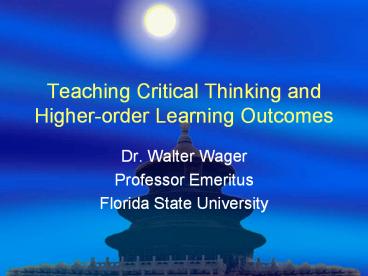Teaching Critical Thinking and Higher-order Learning Outcomes - PowerPoint PPT Presentation
1 / 17
Title:
Teaching Critical Thinking and Higher-order Learning Outcomes
Description:
Teaching Critical Thinking and Higher-order Learning Outcomes Dr. Walter Wager Professor Emeritus Florida State University Plan for this presentation Discuss ... – PowerPoint PPT presentation
Number of Views:308
Avg rating:3.0/5.0
Title: Teaching Critical Thinking and Higher-order Learning Outcomes
1
Teaching Critical Thinking and Higher-order
Learning Outcomes
- Dr. Walter Wager
- Professor Emeritus
- Florida State University
2
Plan for this presentation
- Discuss
- definitions of critical thinking,
- types of learning outcomes and how they are
learned, - the discipline-centric curriculum of
problem-solving and critical thinking - an instructional design model for teaching
critical thinking, - teacher dispositions for teaching critical
thinking.
3
Definitions
- 1943 David Russell A habit of thinking
involving - Knowledge of field
- Attitudes and habits of questioning
- Application of a process or procedure
- Taking action (making decisions and acting on
them)
4
Definitions
- 1991 - Steven Brookfield
- Recognizing and researching assumptions that
undergird thoughts and actions.
5
Definitions
- 1998 Diane Halpern
- The use of cognitive skills or strategies that
increase the probability of a desirable outcome..
Where desirable is defined by the individual,
such as making good career choices or wise
financial investments.
6
Definitions
- 2004 Michael Scriven and Richard Paul
- That mode of thinking about any subject, content
or problem in which the thinker improves the
quality of his or her thinking by skillfully
taking charge of the structures inherent in
thinking and imposing intellectual standards upon
them.
7
Definitions
- Google - Critical thinking 2,600,000 references.
- A tool of inquiry purposeful, self-regulatory
judgment that results in interpretation,
analysis, evaluation, and inference, as well as
explanation of the evidential, conceptual,
methodological, criteriological, or contextual
considerations upon which that judgment is based.
The ideal critical thinker is habitually
inquisitive, well-informed, trustful of reason,
open-minded, flexible, fair-minded in evaluation,
honest in facing personal biases, prudent in
making judgments, willing to reconsider, clear
about issues, orderly in complex matters,
diligent in seeking relevant information,
reasonable in the selection of criteria, focused
in inquiry, and persistent in seeking results
which are as precise as the subject and the
circumstances of inquiry permit. (Retrieved from
http//www.insightassessment.com/dex.html, Oct 6,
2007)
8
(No Transcript)
9
What do they have in common
- A process or strategy for thinking or problem
solving - Attitude or disposition to question knowledge or
beliefs - A sense of inquiry a thirst for knowledge
- Evaluation, decision making , action
- Metacognition reflection on the thought process.
10
Types of learning outcomes that are a part of
critical thinking
- Problem solving
- Knowledge, including information, concepts, and
principles or rules - Attitudes
- Cognitive strategies
11
Types of learning outcomes that are a part of
critical thinking
- Problem solving The learned capability to apply
existing knowledge to a situation that has no
readily apparent solution. The result is both a
solution to the problem and a newly generated set
of rules or procedures.
12
Types of learning outcomes that are a part of
critical thinking
- Knowledge skills including
- information,
- concepts,
- principles or rule using.
- These constitutes prerequisite knowledge use in
problem solving.
13
Types of learning outcomes that are a part of
critical thinking
- Attitudes, a disposition to make good decisions
and work toward understanding. - The student chooses to challenge his or her
assumptions. - Chooses to seek information
- Chooses to be open-minded and flexible
- Chooses to be persistent in seeking results
14
Types of learning outcomes that are a part of
critical thinking
- Cognitive Strategies, Learning skills
- Often first learned as a set of steps or
procedure for approaching a problem or situation. - Later internalized as a way of learning and
thinking - Metacognitive skills self reflection on the
learning process and outcomes.
15
Curriculum for Critical Thinking
- Most critical thinking is discipline oriented
because the knowledge used in problem solving is
generally discipline specific. - There are some general principles, from
economics, and psychology, for example, that
apply to problems across the disciplines. - Problem solving requires the use of prerequisite
skills and knowledge, usually taught in courses,
but seldom practiced with the idea of transfer. - Students need practice thinking outside the
box, and support from peers and teachers. Cross
curriculum problems will aid in cross discipline
thinking.
16
Instructional design modelfor problem solving
and critical thinking
Stating desired outcomes
Evaluating results for feedback and reflection
Choosing an instructional strategy and developing
materials
Delivering instruction, engaging students in
thinking activities
17
Fostering teacher dispositions
- Traditional instructional techniques do not
promote critical thinking. Collaborative
techniques seem more appropriate. - The teacher must also become a critical thinker,
and cognitive mentor for the students. - The opportunity for students to engage in
critical thinking has to be built into the
curriculum. - A critical thinking curriculum has to be valued
by the administration, teachers, students and
parents if changes are going to be made in
schools.































